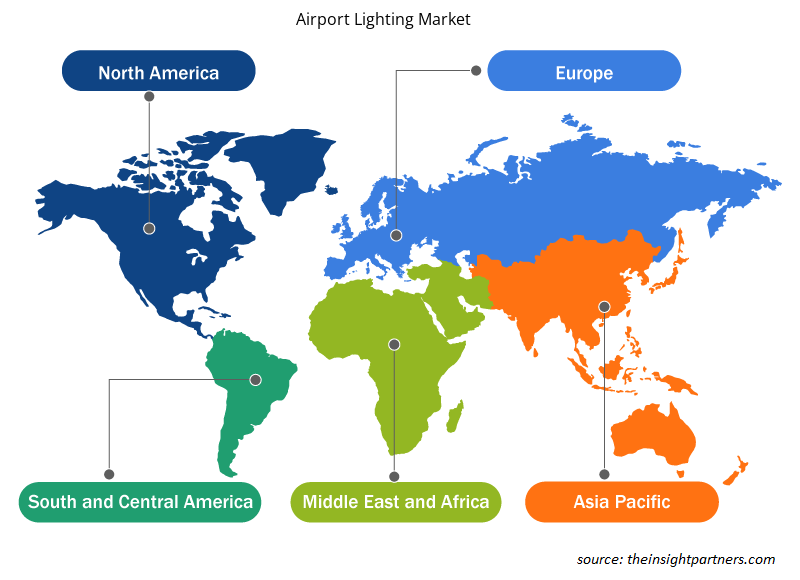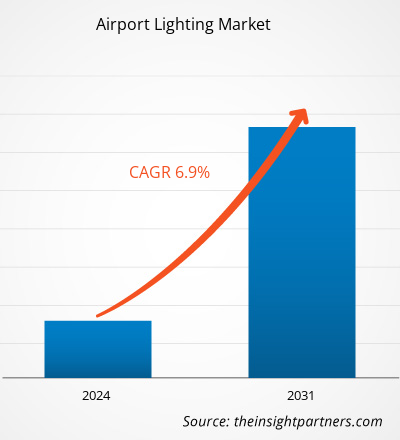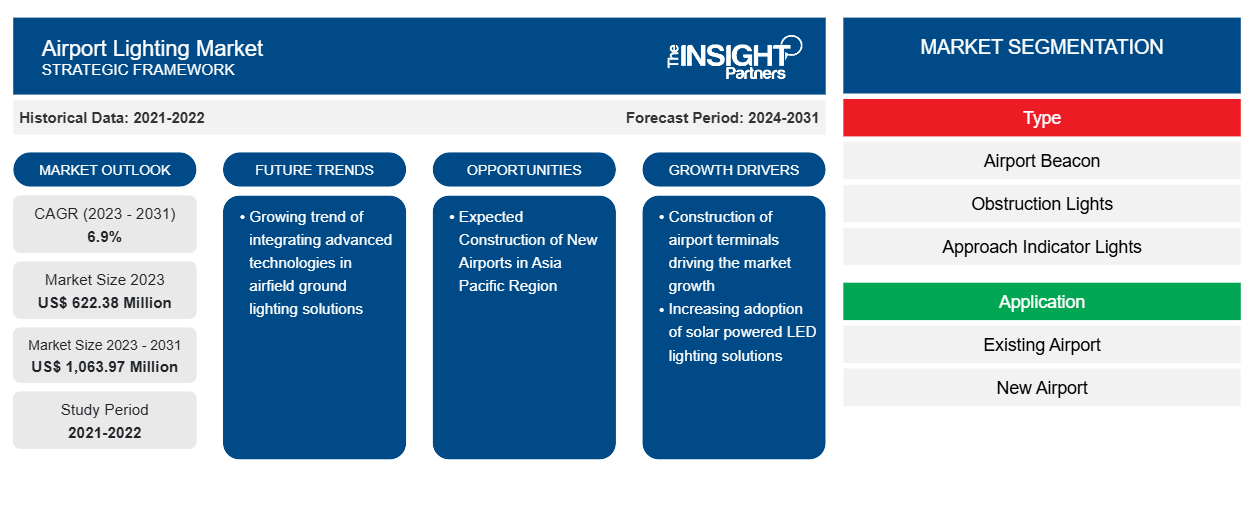Le marché de l'éclairage des aéroports devrait atteindre 1 063,97 millions USD d'ici 2031, contre 622,38 millions USD en 2023. Le marché devrait enregistrer un TCAC de 6,9 % au cours de la période 2023-2031. La tendance croissante à l'intégration de technologies avancées dans les solutions d'éclairage au sol des aérodromes devrait rester une tendance clé du marché.
Analyse du marché de l'éclairage des aéroports
Les fabricants d'éclairage d'aéroport s'approvisionnent en divers composants auprès de différents fabricants de composants et les intègrent à leurs produits. La concurrence entre les fabricants d'éclairage d'aéroport est toujours élevée, en raison de la demande croissante pour cette technologie. De plus, les spécifications de ces solutions d'éclairage sont définies par des certifications, à savoir FAA et ICAO. Le fabricant ou le fournisseur doit rivaliser avec ses pairs en termes de prix, de délai et de services après-vente, ce qui accroît la concurrence sur le marché. Les fabricants de produits vendent leurs produits soit par le biais de canaux de vente directe, soit par l'intermédiaire de distributeurs hors ligne. Les éclairages d'aéroport sont également achetés via des canaux en ligne, ce qui intensifie encore la concurrence entre les acteurs. Parmi les principaux fabricants d'éclairage d'aéroport, on trouve : ADB Safegate, Astronics Corporation, Carmanah Technologies, Honeywell International Inc., OSRAM GmbH et OCEM Airfield Technology, entre autres. Le marché de l'éclairage d'aéroport est fragmenté et plusieurs acteurs opèrent sur le marché, contribuant ainsi à des revenus substantiels d'année en année.
Aperçu du marché de l'éclairage des aéroports
L'analyse de la chaîne d'approvisionnement sur le marché de l'éclairage des aéroports analyse la contribution des acteurs opérant dans l'écosystème tels que les fabricants de matières premières ou de composants, les OEM, les intégrateurs de systèmes, les canaux de vente et les utilisateurs finaux. Les éclairages d'aéroport comprennent plusieurs composants, notamment des câbles à puces LED , des cordons, des supports de lampe, des adaptateurs de support, des suspensions de lampe et des composants métalliques, entre autres. Les fabricants de composants travaillent en synchronisation avec les fabricants d'équipement d'origine qui fournissent ensuite leurs produits directement à l'utilisateur final via plusieurs canaux de vente ou les fournissent à l'intégrateur de système qui conçoit le système requis puis l'intègre à l'aéroport. Pour répondre aux besoins en constante évolution des solutions d'éclairage des aéroports, ces fabricants de composants investissent des sommes importantes dans la conception et le développement d'engrenages robustes. En raison de l'importance de chaque composant, les utilisateurs finaux et les autorités de certification mettent fortement l'accent sur la spécification des mesures. Parmi les fabricants mondiaux de composants d'éclairage d'aéroport figurent Cree Inc., AVS Lighting Components et Inlico, entre autres. Divers autres fabricants de composants opèrent également sur le marché et aident les fabricants d'éclairage d'aéroport à répondre au besoin croissant de telles solutions d'éclairage pour leur clientèle respective.
Personnalisez ce rapport en fonction de vos besoins
Vous bénéficierez d'une personnalisation gratuite de n'importe quel rapport, y compris de certaines parties de ce rapport, d'une analyse au niveau des pays, d'un pack de données Excel, ainsi que d'offres et de remises exceptionnelles pour les start-ups et les universités.
- Obtenez les principales tendances clés du marché de ce rapport.Cet échantillon GRATUIT comprendra une analyse de données, allant des tendances du marché aux estimations et prévisions.
Facteurs moteurs et opportunités du marché de l'éclairage des aéroports
La construction de terminaux aéroportuaires stimule la croissance du marché
Plusieurs projets de construction de terminaux d'aéroport ont été achevés et annoncés en 2023, ce qui a stimulé le marché de l'installation d'éclairages d'aéroport. De plus, les projets à venir pour la construction de nouveaux terminaux d'aéroport devraient stimuler le marché dans les années à venir. Par exemple :
- En janvier 2023, l'aéroport international de Newark Liberty (EWR) a commencé ses opérations passagers dans son nouveau terminal A.
- En février 2023, l'aéroport international de Kansas City (États-Unis) a annoncé l'ouverture de son nouveau terminal unique qui a remplacé ses trois terminaux précédemment opérationnels.
- En mars 2023, l'aéroport d'Auckland (NZL) a annoncé qu'il investirait 3,9 milliards de dollars américains dans son programme d'intégration de terminaux.
- En avril 2023, l'aéroport international de Chennai (IND) a annoncé l'ouverture de son nouveau terminal qui s'étend sur 136 295 m² et a augmenté la capacité de l'aéroport de 23 à 30 millions de passagers par an.
Ces facteurs ont accru la demande d’éclairage aéroportuaire pour les terminaux.
Construction prévue de nouveaux aéroports dans la région Asie-Pacifique
L’augmentation des projets de construction est l’un des principaux facteurs susceptibles d’offrir de nouvelles opportunités aux fournisseurs du marché dans les années à venir. Par exemple, en 2018, l’Administration de l’aviation civile de Chine (CAAC) a annoncé la construction de 216 nouveaux aéroports dans le pays d’ici fin 2035. De même, le gouvernement indien a également annoncé des investissements d’une valeur de 12 milliards de dollars pour la construction de 72 nouveaux aéroports d’ici fin 2025. Ces facteurs sont susceptibles de générer une nouvelle demande de solutions d’éclairage aéroportuaire dans la région Asie-Pacifique et offriront de nouvelles opportunités aux fournisseurs du marché dans les années à venir.markt vendors in the coming years. For instance, in 2018, the Civil Aviation Administration of China (CAAC) announced to construct 216 new airport in the country by the end of 2035. Similarly, the Indian government has also announced the investments worth US$ 12 billion for the construction of 72 new airports by the end of 2025. Such factors are likely to generate new demand for airport lighting solutions across the Asia Pacific region and will provide new opportunities for market vendors in the coming years.
Analyse de segmentation du rapport sur le marché de l'éclairage des aéroports
Les segments clés qui ont contribué à l’élaboration de l’analyse du marché de l’éclairage des aéroports sont le type et l’application.
- En fonction du type, le marché de l'éclairage des aéroports est segmenté en balises d'aéroport , feux d'obstacles, feux indicateurs d'approche, feux d'axe de piste, feux de voie de circulation et autres. Le segment des feux indicateurs d'approche détenait une part de marché plus importante en 2023.
- En fonction des applications, le marché de l'éclairage des aéroports est segmenté en aéroports existants et en nouveaux aéroports. Le segment des aéroports existants détenait une part de marché plus importante en 2023.
Analyse des parts de marché de l'éclairage des aéroports par zone géographique
La portée géographique du rapport sur le marché de l’éclairage des aéroports est principalement divisée en cinq régions : Amérique du Nord, Europe, Asie-Pacifique, Moyen-Orient et Afrique et Amérique du Sud.
L'Asie-Pacifique a dominé le marché en 2023, suivie de l'Europe et de l'Amérique du Nord. En outre, l'Asie-Pacifique devrait également connaître le TCAC le plus élevé dans les années à venir. Cela est principalement dû à la présence d'un grand nombre de nouveaux projets de construction d'aéroports dans les pays de la région APAC dans les années à venir. Par exemple, l'Inde et la Chine ont déjà annoncé la construction de plus de 285 aéroports d'ici la fin de 2035, ce qui devrait encore stimuler la demande de solutions d'éclairage aéroportuaire dans la région.
Aperçu régional du marché de l'éclairage des aéroports
Les tendances et facteurs régionaux influençant le marché de l’éclairage des aéroports tout au long de la période de prévision ont été expliqués en détail par les analystes d’Insight Partners. Cette section traite également des segments et de la géographie du marché de l’éclairage des aéroports en Amérique du Nord, en Europe, en Asie-Pacifique, au Moyen-Orient et en Afrique, ainsi qu’en Amérique du Sud et en Amérique centrale.

- Obtenez les données régionales spécifiques au marché de l'éclairage des aéroports
Portée du rapport sur le marché de l'éclairage des aéroports
| Attribut de rapport | Détails |
|---|---|
| Taille du marché en 2023 | 622,38 millions de dollars américains |
| Taille du marché d'ici 2031 | 1 063,97 millions de dollars américains |
| Taux de croissance annuel composé mondial (2023-2031) | 6,9% |
| Données historiques | 2021-2022 |
| Période de prévision | 2024-2031 |
| Segments couverts | Par type
|
| Régions et pays couverts | Amérique du Nord
|
| Leaders du marché et profils d'entreprises clés |
|
Densité des acteurs du marché : comprendre son impact sur la dynamique des entreprises
Le marché de l'éclairage aéroportuaire connaît une croissance rapide, tirée par la demande croissante des utilisateurs finaux en raison de facteurs tels que l'évolution des préférences des consommateurs, les avancées technologiques et une plus grande sensibilisation aux avantages du produit. À mesure que la demande augmente, les entreprises élargissent leurs offres, innovent pour répondre aux besoins des consommateurs et capitalisent sur les tendances émergentes, ce qui alimente davantage la croissance du marché.
La densité des acteurs du marché fait référence à la répartition des entreprises ou des sociétés opérant sur un marché ou un secteur particulier. Elle indique le nombre de concurrents (acteurs du marché) présents sur un marché donné par rapport à sa taille ou à sa valeur marchande totale.
Les principales entreprises opérant sur le marché de l'éclairage des aéroports sont :
- Porte de sécurité de la BAD
- Éclairage de l'aérodrome
- Société Astronics
- Systèmes Avlite
- Technologies Carmanah
Avis de non-responsabilité : les sociétés répertoriées ci-dessus ne sont pas classées dans un ordre particulier.

- Obtenez un aperçu des principaux acteurs du marché de l'éclairage des aéroports
Actualités et développements récents du marché de l'éclairage des aéroports
Le marché de l'éclairage des aéroports est évalué en collectant des données qualitatives et quantitatives après des recherches primaires et secondaires, qui comprennent d'importantes publications d'entreprise, des données d'association et des bases de données. Quelques-uns des développements du marché de l'éclairage des aéroports sont énumérés ci-dessous :
- Honeywell (NASDAQ : HON) a annoncé aujourd'hui le lancement de son usine de fabrication de feux de route au sol (AGL) à Gurugram, en Inde. L'AGL est un produit fabriqué en Inde, conçu et fabriqué entièrement en Inde. L'AGL joue un rôle crucial dans les opérations aéroportuaires et est soumis à des réglementations complètes en matière de sécurité et de conformité par les organismes de réglementation et de normalisation de l'aviation mondiale. (Source : Honeywell International inc, communiqué de presse, août 2023)
ADB SAFEGATE est heureux d'annoncer le lancement de ses nouveaux luminaires AXON EQ, une gamme de luminaires LED intelligents encastrés dotés de capteurs intégrés pour collecter des données situationnelles. Les luminaires AXON EQ sont équipés de télécommandes LINC 360 intégrées, essentielles pour créer une communication bidirectionnelle qui permet des opérations aéroportuaires plus rationalisées et prédictives. (Source : ADB SAFEGATE, communiqué de presse, mai 2022)
Rapport sur le marché de l'éclairage des aéroports et livrables
Le rapport « Taille et prévisions du marché de l’éclairage des aéroports (2021-2031) » fournit une analyse détaillée du marché couvrant les domaines ci-dessous :
- Taille et prévisions du marché de l'éclairage des aéroports aux niveaux mondial, régional et national pour tous les segments de marché clés couverts par le périmètre
- Tendances du marché de l'éclairage des aéroports ainsi que la dynamique du marché, telles que les facteurs déterminants, les contraintes et les opportunités clés
- Analyse détaillée des cinq forces du porteur
- Analyse du marché de l'éclairage des aéroports couvrant les principales tendances du marché, le cadre mondial et régional, les principaux acteurs, les réglementations et les développements récents du marché
- Analyse du paysage industriel et de la concurrence couvrant la concentration du marché, l'analyse de la carte thermique, les principaux acteurs et les développements récents du marché de l'éclairage des aéroports
- Profils d'entreprise détaillés
- Analyse historique (2 ans), année de base, prévision (7 ans) avec TCAC
- Analyse PEST et SWOT
- Taille du marché Valeur / Volume - Mondial, Régional, Pays
- Industrie et paysage concurrentiel
- Ensemble de données Excel
Rapports récents
Témoignages
Raison d'acheter
- Prise de décision éclairée
- Compréhension de la dynamique du marché
- Analyse concurrentielle
- Connaissances clients
- Prévisions de marché
- Atténuation des risques
- Planification stratégique
- Justification des investissements
- Identification des marchés émergents
- Amélioration des stratégies marketing
- Amélioration de l'efficacité opérationnelle
- Alignement sur les tendances réglementaires





















 Obtenez un échantillon gratuit pour - Marché de l'éclairage des aéroports
Obtenez un échantillon gratuit pour - Marché de l'éclairage des aéroports